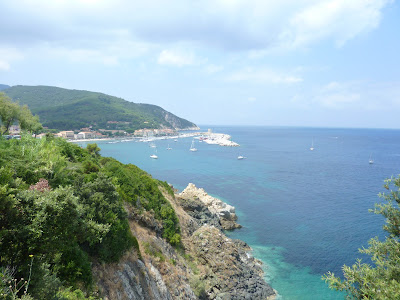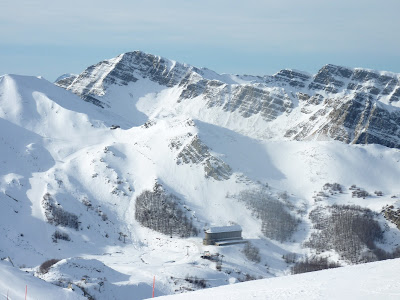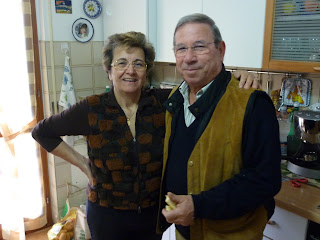Before I started spending a lot of time in Tuscany I had heard bits and pieces about Elba Island but honestly it just went in one ear and out the other. I recalled from my college French classes that Napoleon I had been exiled there, and I had always pictured a desolate, barren and wind-swept stretch of sand with the feisty French emperor moping behind bars in a cement shack, gnawing stale bread and moldy cheese, vengefully plotting his escape route.
Then, one rainy day last June, a colleague of mine from Castello di Casole (a private estate near Siena where I sell luxury farmhomes) who has family in Elba was raving about the island and my curiosity was piqued. I had been craving sunshine and salt air so I invited my friend Barbara to join me for a quick three-day getaway. Other than a few tips we’d been given from Italian friends, neither one of us knew a thing about the island nor did we have time to prepare, so we booked a random hotel in Porto Azzurro which someone said would be the best place for us to stay, and we took off.
Elba is surprisingly easy to reach. You can take the train to Piombino Marittima then a short bus ride to the ferry and then forty-five minutes later you are there. Barbara and I opted to drive two hours to Piombino and bring my car on the ferry so that we could explore as much of the island as possible.
As our ferry chugged across the Tyrrhenian Sea towards the largest port town, Portoferraio, I was immediately struck by the size of the island. Elba is the largest island in the Tuscan archipelago and the third largest in all of Italy after Sardinia and Sicily. At 86 square miles or 150 kilometers around, it takes several hours to drive from one end to the other. The landscape is surprisingly lush and parts are heavily forested. Underneath lies what was once a treasure trove of minerals and semiprecious stones, though there are still a few active mines on the island today. The hilly interior is peppered with olive groves and vineyards and a cable car runs up the highest “mountain” Monte Capanne. Nestled in coves all along the coastline are more than fifty beaches. Those on the quieter west side are sandier though harder to reach while the more rugged east side has high cliffs and stony beaches.
Italians will shake their heads in disappointment when they read this, but since our ferry was arriving in Portoferraio anyways, Barbara and I decided to kick off our visit with a tour of Napoleon Bonaparte’s residence, Villa dei Mulini, in the city center. A far cry from a cement shack, the once grand two-story villa is now weathered and its gardens are sadly overgrown. Some exquisite furnishings, such as Napoleon’s desk and library, remain, and the views framing a lighthouse are stunning.
A quick tour of the villa gave me a chance to brush up on this obscure part of French history which I will impress you with now: When Napoleon was defeated in 1814 and the Treaty of Fontainebleau was signed, the allies shipped him off to Elba, made him governor of the island, handed him two million francs and a volunteer army of 400, built a plush villa for him in the main port town and another equally plush villa in the countryside for weekend getaways. And they let him keep his title “Emperor.” Not bad for a chap who conquered northern Italy, occupied Egypt, invaded Austria, Russia, Britain, Holland, Switzerland, Turkey, Spain and Portugal, killing thousands of people, demolishing historic buildings and pilfering priceless art along the way….
During his 300 days as sovereign, when he wasn’t masterminding his short-lived return to glory before being defeated once and for all at Waterloo, the kinder, gentler side of Napoleon carried out a number of economic and social reforms on Elba and added roads and other forms of infrastructure that remain to this day. His stay on the island is the basis for the famous English palindrome (which I recall from high school English is a phrase that can be read the same way in either direction): "Able was I ere I saw Elba” whatever the #$*% that means…
But enough of the little French Emperor. Barbara and I had made it our mission to find the best stretches of sand on the island so we spent that afternoon and the whole next day beach hopping. One thing I love about the beaches on Elba is that there is so much variety. On a day in early June before the hoards of summer vacationers descend on the island in July and August, for example, you can can opt for a beach like this:
Or one like this:
The closest beaches to Portoferraio are around Capo Enfola just 20 minutes north so we headed there first. The one we liked the most, Sansone, doesn't have a grain of sand on it. Its shore is a deep, sprawling mass of white, silky-smooth rocks and lying on them is like getting a hot stone massage, only a lot cheaper. The water is the clearest I have ever seen and since you have to hike fifteen minutes down a fairly steep footpath, it is not too crowded. Parking along the street is limited so my advice is to arrive early, and bring walking shoes, water, snacks and an umbrella. Also don’t forget your bathing suit like I did. (I wanted to shoot myself, and bikini-clad Barbara, when I realized my oversight.)
Driving along the windy roads around the island between beaches is exhilarating. You never know what surprise lies around the next bend. Panoramic views of emerald green meadows and the azure blue sea alternate with bouquets of yellow scotch broom, purple thistle and red poppies in full bloom in June.
Heading southeast to the Golfo (gulf) Stella near the town of Capoliveri, we discovered two lovely beaches adjacent to one another, Barabarca and Zuccaro. Both have simple little bars with terraces where you can have a nice lunch looking out at the sea. Barabarca has an approach so gorgeous it literally stops you in your tracks.
Norsi beach, a local’s secret covered in tiny pebbles, has a fun bar in a thatched-roof hut right out of the Bahamas.
The sandy, longer beaches, like Lido, where you can windsurf, rent a rubber dinghy or a pedal boat, and splash around with screaming kids, really draw the crowds. They are ideal for families and not ideal for two single gals searching for a little peace and quiet. We were at Lido beach for a matter of seconds, just long enough for me to leave my cell phone on the seat of a motorbike while dusting the sand off my feet. Thirty minutes later, after searching the car, my beach bag and the parking lot several times, Barbara had the bright idea of calling my phone and we heard its feeble ring in the distance ….(That time it was Barbara who wanted to shoot me.)
Had we been there for more than 48 hours we would have ventured to the wilder, quieter west side of the island, or we would have parked it somewhere for a few hours and really relaxed, but we were on a mission and so we persevered, visiting more than ten beaches in two days. It was exhausting. However rather than waste precious time recovering that first afternoon with a nap, we decided to head to Porto Azzuro for a little pick me up after quickly checking in at our random hotel that was so terrible I wanted to jump out the window the minute we entered our room. I had been warned that moderately priced hotels on Elba have “lower standards” than their counterparts elsewhere in Tuscany but this was ridiculous. (I have heard good things about Villa Ottone which is among the island's few luxury hotels.) Fortunately we had driven by another cheerful, inviting hotel called Cala di Mola with a huge swimming pool and great views of the picturesque harbor that, praise God, had a room for us. I would recommend Cala di Mola to anyone visiting Elba on a moderate budget who doesn’t mind the color orange.
And after a long day at the beach you can also partake in a rigorous exercise class in the pool...
In serious need of a calming elixir, we drove into Porto Azzurro and discovered an inviting bar fittingly named El Curando (“the doctor” in Spanish) in a postcard-perfect piazza. Within minutes I was sipping the best margarita I have had in all of Tuscany listening to Van Morrison and recapping the day’s adventures with Barbara and my friend Daniela who had joined us for the evening. Had we not had a dinner reservation I could have sat there all night.
However, Daniela who always manages to find the best restaurants everywhere we go, had reserved a table at a seafood place just steps from our hotel, run by an, er, slightly attractive friend of hers named Stefano.
There are certain vistas along the Pacifica Coast Highway in California so stunning they can literally bring me to my knees. I had that same sensation when I descended the stairs down to La Caletta and laid eyes on Stefano. No sorry. I meant I had that same sensation when I descended the stairs and landed on the terrace of La Caletta.
There are certain vistas along the Pacifica Coast Highway in California so stunning they can literally bring me to my knees. I had that same sensation when I descended the stairs down to La Caletta and laid eyes on Stefano. No sorry. I meant I had that same sensation when I descended the stairs and landed on the terrace of La Caletta.
 The setting for this restaurant is so perfect it actually felt fake. I was spellbound by the views of the serene harbor below, sailboats swaying gently in the breeze. The raw fish on the platter I started off with was so fresh it could have leapt out of the sea right onto my plate. My second course, the Zuppa di Mare, was a heaping, steaming mass of shrimp, mussels, clams and fish floating in a rich, spicy, broth begging for a wedge of crusty fresh bread.
The setting for this restaurant is so perfect it actually felt fake. I was spellbound by the views of the serene harbor below, sailboats swaying gently in the breeze. The raw fish on the platter I started off with was so fresh it could have leapt out of the sea right onto my plate. My second course, the Zuppa di Mare, was a heaping, steaming mass of shrimp, mussels, clams and fish floating in a rich, spicy, broth begging for a wedge of crusty fresh bread. On our second night, following another day of rigorous beach hopping, Barbara and I took our sun-soaked selves up to the little medieval hilltop town of Capoliveri. As we joined the locals for their evening passeggiatta (stroll) through winding cobbled streets and alleys, sultry lounge music drifted out from the bars and beckoned us into shops.
Eventually we wound our way to Il Chiasso, (which means “narrow lane”), a fantastic restaurant housed in what used to be donkey stables cleverly renovated with tables filling every nook and cranny inside and out. Luciano, the chef and proprietor since the restaurant opened in 1973, dances his way around his guests all the while entertaining them with jokes and smiles. We were fortunate to get a table outside where a three-piece band was playing live jazz and Luciano just kept bringing plates of food to our table. My favorite dish was a local fish called “ricciola,” served raw and finely chopped with champignons and raspberry vinaigrette. It was close to midnight when we reluctantly bid farewell to Luciano and as we made our way back to the car there were even more locals of all ages out chatting in the piazzas, eating gelato, little kids scampering around. Every one seemed happy, relaxed and not wanting that beautiful summer night to end.
During that long weekend, I was so struck by the lush natural beauty of the island, its crystal clear waters, and welcoming people, that I found myself thinking longingly about Elba all winter long and returned again with another friend, Beth, this past June for three more blissful days. This time we rented motorbikes and discovered some new treasures on the island. I’ll save that story for another day.






























































